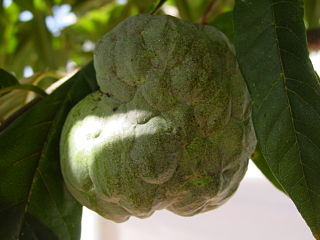
The Annonaceae are a family of flowering plants consisting of trees, shrubs, or rarely lianas commonly known as the custard apple family or soursop family. With 108 accepted genera and about 2400 known species, it is the largest family in the Magnoliales. Several genera produce edible fruit, most notably Annona, Anonidium, Asimina, Rollinia, and Uvaria. Its type genus is Annona. The family is concentrated in the tropics, with few species found in temperate regions. About 900 species are Neotropical, 450 are Afrotropical, and the remaining are Indomalayan.
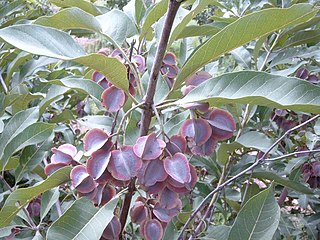
Combretum, the bushwillows or combretums, make up the type genus of the family Combretaceae. The genus comprises about 272 species of trees and shrubs, most of which are native to tropical and southern Africa, about 5 to Madagascar, but there are others that are native to tropical Asia, New Guinea and the Bismarck Archipelago, Australia, and tropical America. Though somewhat reminiscent of willows (Salix) in their habitus, they are not particularly close relatives of these.

Anonidium is a genus of plants in family Annonaceae.
Isolona is a genus of flowering plants in the family Annonaceae. There are 21 species native to Africa. They occur in humid habitat types.
Isolona zenkeri is a species of plant in the Annonaceae family. It is found in Cameroon, The Republic of the Congo and Gabon. Adolf Engler, the German botanist who first formally described the species, named it after Georg August Zenker who collected the sample Engler examined. Its natural habitat is subtropical or tropical moist lowland forests. It is threatened by habitat loss.

Monodora is a genus of plant in family Annonaceae. It contains approximately 15 species, distributed throughout tropical Africa.
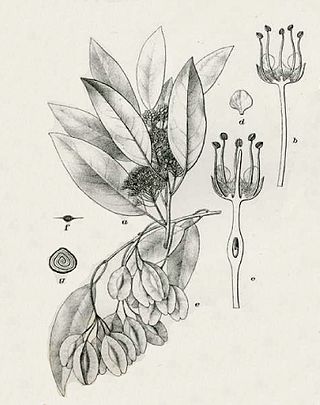
Pteleopsis is a genus of plant in the family Combretaceae. PteleopsisEngl. is often considered a synonym of TerminaliaL., another genus of the same family which contains around 290 species.
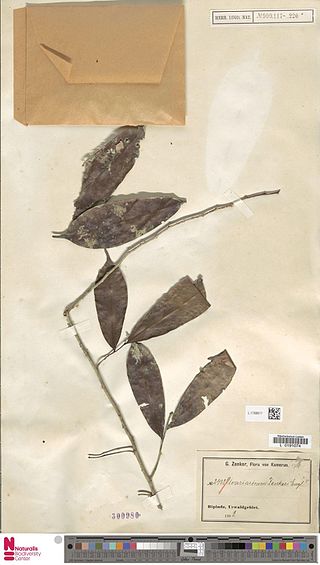
Uvariastrum is a genus of plants in the Annonaceae endemic to sub-Saharan Africa. One species of the genus grows in a drier woodland habitat, whereas the other species are found in the tropical lowland rain forests.

Uvariopsis is a genus of flowering plants in the family Annonaceae. The genus is unique to Africa, and consists of about 18 species, all of which are either ramiflorous, cauliflorous or both.

Cyphia is a genus of flowering plants in the bellflower family, native to Africa; and particularly South Africa. It has been placed in its own subfamily, Cyphioideae. It is closely related to the genus Lobelia.Cyphia comes in shades of white to mauve, whereas lobelias have strong colours of blue to purple. Species in this genus have a bilabiate corolla; with 3 lobes on top and 2 below.
Uvariopsis zenkeri Engl. is a species of flowering shrub in the family Annonaceae endemic to Cameroon and the Central African Republic.
Asteranthe asterias is a species of plant in the family Annonaceae. It is native to Kenya and Tanzania. Spencer Le Marchant Moore, the English botanist who first formally described the species using the basionym Uvaria asterias, did not explicitly explain the epithet, but was likely referencing the star-like appearance of its flower’s petals.
Meiocarpidium is a genus of plants in the family Annonaceae. It is distributed in Cameroon, The Central African Republic, The Republic of the Congo, and Gabon. Adolf Engler and Ludwig Diels, the German botanists who first formally described the genus, named it after the small number of carpels in the flowers.
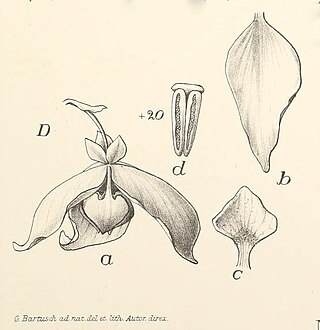
Monodora junodii is a species of plant in the family Annonaceae. It is native to Eswatini, Kenya, Malawi, Mozambique, South Africa, Tanzania, and Zimbabwe. Heinrich Gustav Adolf Engler and Ludwig Diels, the German botanists who first formally described the species, named it after Henri-Alexandre Junod, the Swiss missionary and scientist who collected the specimen that they examined.
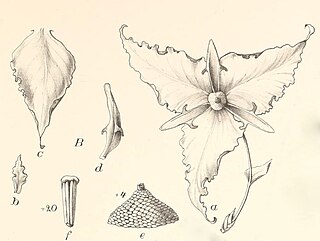
Monodora minor is a species of plant in the family Annonaceae. It is native to Mozambique and Tanzania. Heinrich Gustav Adolf Engler and Ludwig Diels, the German botanists who first formally described the species, do not explicitly explain the specific epithet but it is among the smaller members of the genus which includes species that reach heights of 30-40 meters.

Mischogyne elliotiana is a species of plant in the Annonaceae family. It is native to Cameroon, Gabon, Ghana, Guinea-Bissau, Ivory Coast, Liberia, Nigeria, Sierra Leone, and Zaire. Adolf Engler and Ludwig Diels, the German botanists who first formally described the species using the basionym Uvaria elliotiana, named it after George Scott-Elliot the botanist who collected the specimen they examined.

Annonoideae is a subfamily of plants in the family Annonaceae, with genera distributed in tropical areas world-wide. The family and this subfamily are based on the type genus Annona.
Cleistopholis is a genus of flowering plants belonging to the family Annonaceae.

Uvariastrum pierreanum is a species of plant in the Annonaceae family. It is native to Cameroon, the Central African Republic, the Democratic Republic of the Congo, Equatorial Guinea, Gabon, Ghana, Guinea, the Ivory Coast, Liberia, Nigeria, Sierra Leone and the Republic of the Congo. Adolf Engler, the botanist who first formally described the species, named it after the French botanist Jean Baptiste Louis Pierre.












